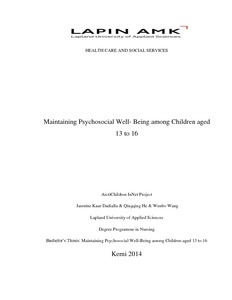Maintaining Psychosocial Well- Being among Children aged 13 to 16
Wang, Wenbo; He, Qingqing; Dadialla, Jasmine Kaur (2014)
Wang, Wenbo
He, Qingqing
Dadialla, Jasmine Kaur
Lapin ammattikorkeakoulu
2014

Creative Commons Attribution 3.0 Unported
Julkaisun pysyvä osoite on
https://urn.fi/URN:NBN:fi:amk-2014120818878
https://urn.fi/URN:NBN:fi:amk-2014120818878
Tiivistelmä
Children are the future of our society, and children at the ages of 13 to 16 are especially vulnerable to factors that may be detrimental to their psychosocial well-being. The purpose of this thesis is to find out what children aged 13 to 16 express their psychosocial well-being as. Psychosocial is one part of the general well-being of an individual and it is the duty of everybody in the community to promote the well-being of children aged 13 to 16, including their psychosocial well-being. The aim of this thesis is to provide evidence to support the need that children need help in maintaining their psychosocial well-being and how we, as citizens, may be able to help promote their psychosocial and eventually general well-being.
The theoretical background of this thesis is constructed around the growth and developmental factors, parenting and family environments, social and community environments and the maintenance and promotion of the psychosocial well-being of the child. This thesis has been conducted as part of the ArctiChildren InNet project (2012-2014) and the goal of the authors is to make this material available to school staff, parents, peers and health care professionals as well as community members so as to learn and understand how to promote the psychosocial well-being of children aged 13 to 16. This material could also be used to help build the Chat Simulation being built by the project to help improve eHealth portals and channels.
The research method used in this study is narrative literature review. This study critically analyses 8 research article and forms conclusions based on the information gleaned from these articles. These are then used to support the claims of the authors.
The articles and materials used and reviewed in this thesis were collected from reputable and reliable databases, e-journals and reputed books. The results of the narrative review of this study shows that children understand their psychosocial well-being as being maintained by resilience, good interpersonal relationships and secondary factors like good social cohesion, economic factors, identifying and respecting the cultural identity, changing the school systems to cater to the more modern needs of students, improved quality of life, physical health, improved interventions and reduced limitations to daily living. These factors seem to be the components that make up and maintain psychosocial well-being in children aged 13 to 16.
The theoretical background of this thesis is constructed around the growth and developmental factors, parenting and family environments, social and community environments and the maintenance and promotion of the psychosocial well-being of the child. This thesis has been conducted as part of the ArctiChildren InNet project (2012-2014) and the goal of the authors is to make this material available to school staff, parents, peers and health care professionals as well as community members so as to learn and understand how to promote the psychosocial well-being of children aged 13 to 16. This material could also be used to help build the Chat Simulation being built by the project to help improve eHealth portals and channels.
The research method used in this study is narrative literature review. This study critically analyses 8 research article and forms conclusions based on the information gleaned from these articles. These are then used to support the claims of the authors.
The articles and materials used and reviewed in this thesis were collected from reputable and reliable databases, e-journals and reputed books. The results of the narrative review of this study shows that children understand their psychosocial well-being as being maintained by resilience, good interpersonal relationships and secondary factors like good social cohesion, economic factors, identifying and respecting the cultural identity, changing the school systems to cater to the more modern needs of students, improved quality of life, physical health, improved interventions and reduced limitations to daily living. These factors seem to be the components that make up and maintain psychosocial well-being in children aged 13 to 16.
